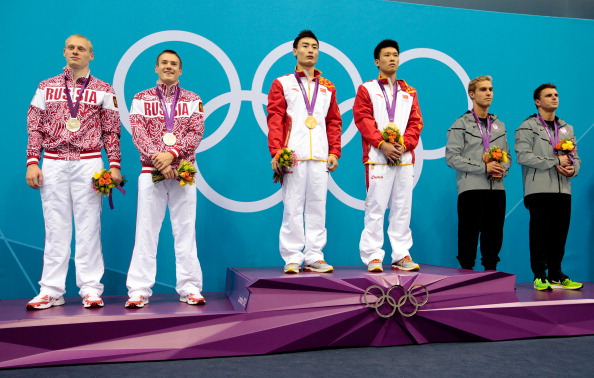You can follow the Olympics two ways. First, there’s the right way: you pay attention to the athletes and root for great performances. You see them cry and hug each other in joy or look away in disgust at a bad performance. You empathize with them as human beings and debate issues like whether Michael Phelps is the greatest Olympian of all time or just the greatest swimmer. You wonder about doping but try to believe that the sports agencies have it more or less under control and that Dick Pound is just another Canadian curmudgeon.
Then there’s the way I watch the games: as a statistical survey of geopolitics and destructive public policy. Individuals matter, to a degree, but more as products of systems than as distinctive personalities. I admire Ye Shiwen’s performance but wonder more about why the country’s swimming coaches get paid almost as much as the central government spends on preserving the country’s dying folk culture. I think Phelps is a great physical specimen but wonder why Americans are getting fatter and fatter. And I look in bemusement at Great Britain’s sudden rise up the medals table—the telltale sign of a country with an inferiority complex that has decided to spend lots and lots of money on attention-getting elite sports: modern-day penis envy.
The Olympics used to be a lot easier to follow. For its first half-century, it was a much smaller event often interrupted by wars; only Hitler seemed to realize the games’ PR potential. Then came the Cold War and they turned into a battleground for rival ideologies. Countries like East Germany and the Soviet Union poured huge amounts of money into sports as a way to earn recognition. Especially East Germany, which craved respectability, had an almost pathological desire for Olympic success. In just five summer games, it racked up 409 medals.
Most people think the Eastern Bloc’s success was simply a question of massive doping—women with Adam’s apples and beards. But smart countries realized there were other explanations for the success. Warsaw Pact governments spent a huge amount of money on sports, true, but the key was that they ruthlessly targeted only likely medal winners. East Germany, for example, never bothered with ice hockey because it realized it would have to train at least two dozen elite athletes just to field a team and even then would have a tough time against established powerhouses. Instead, it focused on sports where one athlete could win multiple medals—speed skating and cycling for example. It also avoided sports that depended on having leagues (ice hockey, basketball, baseball and so on); better to support athletes who trained alone because they required less infrastructure. And of course athletes like Katarina Witt got enough money—and national prominence—to make it a profession. Amateurism was for losers.
Even before the Cold War ended, western countries were emulating these tactics. South Korea made a splash at the 1988 Seoul games by winning more gold medals than West Germany and landing in fourth place in the medal count. Australia went even further: After failing to win a gold medal at the 1976 Montreal games, it set up a centralized sports bureaucracy that set new athletic standards and channeled money to training programs and especially to winners. Despite its small population, it finished fourth in the medal counts in Sydney and Athens (although it slid to sixth in Beijing and seems to be doing even more poorly in London).
Australia’s problems reflect increased competition and the fact that democracies have greater difficulty maintaining high funding for luxuries like elite sports. Other countries with even more money and people began to funnel money into elite sports with gold-medal prospects. Interestingly, the IOC implicitly supports this gold-first mentality. Although it doesn’t endorse a medals table, its site
features a medals table that ranks countries by gold, ignoring silver and bronze except as tie-breakers. This highlights the fact that only soft-headed North Americans rank countries by total medal count. For everyone else in the world, gold is what matters.
Most notably, Germany has reversed course and started reopening East German-style athletic schools. The centerpiece is the enormous Schooling and Performance-Sport Center in a suburb of eastern Berlin not far from the Stasi’s Hohenschönhausen prison. (This is not a cheap shot; the two were part and parcel of the party’s ruling apparatus.) For years the school rotted, with only a small portion kept open as a high school. Now, the school is being renovated. The swimming pool has been reopened and former East German trainers brought back. Although doping is banned and the training regimes are not as extreme, it is a radical change for a country that had been revolted by the excesses of the East German sports machine, which was mostly shuttered in the 1990s.
Advertisement
But Germany’s efforts are only just beginning—the country is on course for one of its worst showings at an Olympics—and in any case pale with China’s. The Chinese government does not publicize its elite sporting budget but the scale of it is awesome. According to Australian press reports, foreign trainers get $250,000 per gold medal, $150,000 for a silver and $100,000 for a bronze. Ye’s coach, Ken Wood, has said that “money is no object,”
as the athletes arrive with teams of trainers, coaches, and cooks and live in luxury apartments.
The comparison to folk culture is that, according to a senior Chinese official I interviewed earlier this year, China spends $2 million a year for protecting folk arts like music, drama and dance.
Picking on China, however, is unfair. Every country has needs more worthy than a gold medal for an athlete. While Sports England—the mass sporting organization aimed at public participation and health—cut grants this year to £82 million from £98 million in 2011, UK Sports (which funds elite sports) will dole out £264 million for the London games, most of it focused on the handful of sports where Britain is able to reap gold. That makes it unlikely that the games will do much to bolster public participation; indeed, playgrounds are being sold to cut the budget deficit.
What of the United States? It does not have a centralized sports agency to account for its prowess. Instead, its success reflects something at once more refreshing but also insidious. On the positive side, the United States has a vibrant civil society with many philanthropists eager to help out. Most recently, Nike has helped pour money into distance running, helping to [revitalize US chances] (http://www.newyorker.com/reporting/2008/08/11/080811fa_fact_hessler) there while high schools and universities have an elaborate network of facilities. None of this is the result of a government scheme to dupe the citizenry with bread and circuses.
But that reflects the bad side—the fact that much of the US sports success is due to misplaced priorities that begin at the grassroots level. I attended the University of Florida, the alma mater of swimmer Ryan Lochte, who won two golds in London. This is a school that has gone crazy about sports, building a professional-sized football stadium and lavish facilities for its athletes. The university claims that sports is separate and self-supporting but the effect on the campus was debilitating. The school offers easy majors for athletes and fosters a culture of sports being on a par with academics. At times it felt that one was attending a sports school with other majors attached.
Sports has become so consuming in the United States that families spend outrageous amounts of money on children with elite athletic potential. Lochte’s parents had their home foreclosed, while gymnast Gabby Douglas’s mother declared bankruptcy. None of this means Americans are more active or healthy than elsewhere. For most, sports is something to be viewed, or compartmentalized into an activity done on very expensive equipment or in very expensive clubs once or twice a week.
So how do countries compare statistically? One of my favorite websites these games has been on a German television station, ARD, which has a “medal barometer” that allows you to plot a country’s gold medals over time. The page is in German but it’s easy to use: click on as many countries as you like and the software plots the golds of each country against each other. (Click on the country again to remove it from the chart.) It’s hard not to see this as some sort of proxy for a nation’s rise. Plot China against the United States and you’ll see a traditional powerhouse facing a country that has come out of nowhere to top it. And if you plot regions—the page allows for that—you can see the rise of Asia and the decline of Europe.
It appears less benign when you know the power of money. Plot Australia and watch its rise and fall. Or compare Germany, a traditional sporting powerhouse with fantastic public sports facilities, versus the UK, which is a western version of China—a country with limited public sports infrastructure and little public participation but hell-bent on winning gold. This graph won’t be lost in Germany, which will probably allot even more money to elite sports and squeeze public facilities further.
What probably most people forget is that 77 of the world’s countries or territories have never won a single medal. If they weren’t for the most part poor, one might consider them the lucky ones—free from the arms race that has consumed the would-be champions.
Advertisement




